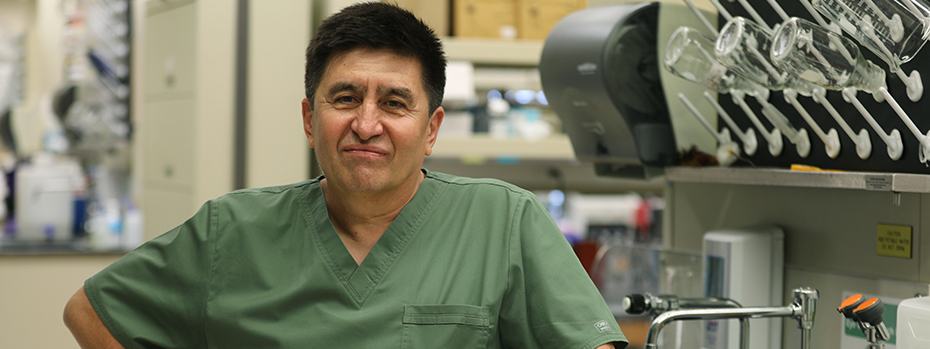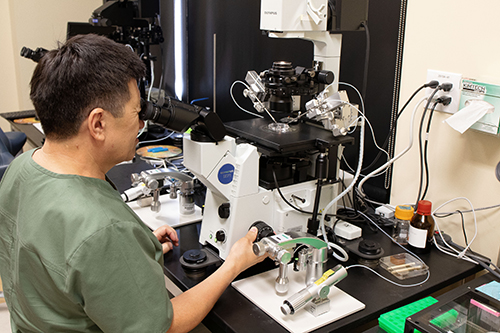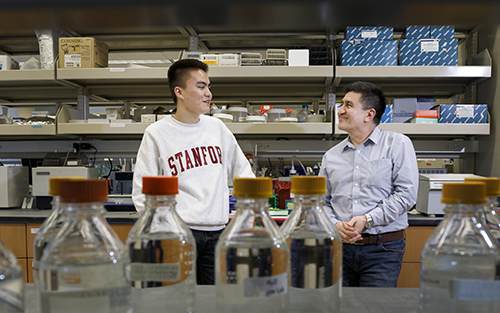Meet Shoukhrat Mitalipov, Ph.D.

His pioneering work with mitochondria could help eliminate genetic disease
Shoukhrat Mitalipov, Ph.D., the powerhouse leading OHSU’s Center for Embryonic Cell and Gene Therapy, has dedicated his career to the study of mitochondria.
“My colleagues, they say I’m a ‘mitochondriac,’ that I only see this one thing,” he told The New York Times in a 2014 interview. “Maybe they are right.”
Mitochondria produce energy and are found in nearly every human cell. They’ve often been overlooked in scientific study, but Dr. Mitalipov has spent decades studying their secrets. His research in the field of mitochondrial replacement therapy offers a glimpse at a future without devastating genetic diseases.
From the Soviet Union to OHSU
Dr. Mitalipov was born in 1961 in Almaty, Kazakhstan, then part of the Soviet Union. Beginning in 1979, he served two years in the Soviet military as an army radio technician. After his military service, he studied genetics at the Timiryazev Agricultural Academy in Moscow, where he earned his master’s degree.
He spent a short time as a chief livestock specialist at a collective farm in the Yaroslavl region. Then, he earned his Ph.D. in developmental and stem cell biology from the Research Centre of Medical Genetics in Moscow. His research lab there was the only one in the Soviet Union that was studying embryonic stem cells.
The fall of the Soviet Union in 1991 made funding for stem cell research hard to come by. In 1995, Dr. Mitalipov won a postdoctoral fellowship from the United States to conduct research at Utah State University, where he worked on cloning livestock animals using somatic cell nuclear transfer (SCNT).
But in 1998, he jumped at the chance to move to the Oregon National Primate Research Center at OHSU. Here he could work with monkeys, which share 98 percent of their DNA with humans.

Mitochondrial replacement therapy
Dr. Mitalipov and his team received major recognition in 2009 for their pioneering work on mitochondrial replacement therapy.
He mastered the technique of removing the cytoplasm and mitochondria from one human egg and replacing it with the donor cytoplasm and mitochondria from another egg. This gene therapy is designed to avoid passing on certain genetic defects found in an egg’s mitochondria. Mitochondrial disorders affect the body’s ability to produce energy and control respiration and can be devastating for those living with them.
Mitochondrial replacement therapy can be controversial. Because mitochondria contain their own DNA (mtDNA), an egg that goes through the therapy will contain nuclear DNA from the mother but mtDNA from the donor egg.
In 2020, a decade after the first rhesus monkeys were born from eggs processed by mitochondrial replacement therapy, Dr. Mitalipov and his team published a study that showed the monkeys and their offspring had no adverse health effects from the treatment. More recently, his team successfully tested mitochondrial replacement therapy in clinical trials in humans to treat female infertility and reported the births of healthy children. It’s promising evidence that the therapy could be effective in human patients, though clinical applications are not allowed in the United States yet.
For now, the treatment Dr. Mitalipov and his team pioneered at OHSU is available to patients only in the United Kingdom, Australia and Greece.

Turning skin cells into stem cells
In 2013, Dr. Mitalipov and his team published a study in Cell about a new process to create human stem cells from skin cells.
Stem cells hold promise for treating various degenerative diseases because they can be reprogrammed into any other cell type. But finding a source of embryonic stem cells is challenging.
Dr. Mitalipov’s process is called somatic cell nuclear transfer, or SCNT. In SCNT, the nucleus is removed from a human donor's unfertilized egg and replaced with DNA from human skin cells. The technique can make embryonic stem cells from a patient’s skin cells, a discovery that could lead to treatments for a vast range of conditions caused by diseased or injured cells.
The discovery was reported internationally and was named among the top 10 scientific breakthroughs of the year.
Groundbreaking genetic editing
In 2017, Dr. Mitalipov and his team stunned the world by “correcting” in human embryos a genetic mutation that causes heart disease. What’s more, they may have been able to edit the DNA without introducing the harmful mutations seen in previous attempts.
They targeted the MYBPC3 gene, which causes hypertrophic cardiomyopathy. In this disease, a muscle in the heart thickens, making it harder for the heart to pump blood. In many cases there are no symptoms, but it can lead to sudden cardiac death.
Dr. Mitalipov used the gene editing tool CRISPR-Cas9 to snip out the gene that causes hypertrophic cardiomyopathy. Dr. Mitalipov’s innovation was to introduce CRISPR-Cas9 at the same time sperm was being injected into the egg — and the results were remarkable. About 72 percent of the embryos in the study were corrected and the MYBPC3 gene was eliminated.
“Really we didn’t edit anything. Neither did we modify anything,” Dr. Mitalipov told The Washington Post when the study was published. “Our program is toward correcting mutant genes.”
Dr. Mitalipov hopes that the technique could be used to eliminate other diseases. One of the team’s next potential targets? The BRCA gene mutation, which contributes to breast cancer.
The excitement of discovery
Dr. Mitalipov has won many awards for his work, including the American Society of Reproductive Medicine Distinguished Researcher Award. He was named one of Nature’s 10 People Who Mattered in 2013.
But what drives him in his work, he says, is the excitement of discovery and what his research could mean for future patients.
“You don’t want to say, ‘My science will help 100 years from now,’” Dr. Mitalipov said in a 2016 interview with STAT. “Maybe it will, but I want it while I’m here.”
Learn more about Dr. Mitalipov
- TIME Health Care 50: Designing Disease-Free Embryos, TIME Magazine
- Shoukhrat Mitalipov's Mitochondrial Manipulations, The New York Times, March 2014
- First human embryo editing experiment in U.S. ‘corrects’ gene for heart condition, The Washington Post, August 2017
- CRISPR: The gene-editing tool revolutionizing biomedical research, 60 Minutes, April 2018
- First he pioneered a new way of making life. Now he wants to try it in people, STAT, July 2016
Awards
Dr. Mitalipov has won many awards for his work, including:
- Nature’s 10 People Who Mattered 2013
- 2023 Distinguished Researcher Award, American Society for Reproductive Medicine
- 2010 Discovery Award, The Medical Research Foundation of Oregon
- 2010 Women’s Health Research Award, the Center for Women’s Health, Circle of Giving
- 2017 Thousand Talents Plan Award in China in the category of the Recruitment Program for Foreign Experts
Positions
- Professor, Oregon National Primate Research Center
- Professor of Obstetrics and Gynecology, School of Medicine
- Professor and Director, Center for Embryonic Cell and Gene Therapy
Resources for media
Download photos and more resources about Dr. Mitalipov.